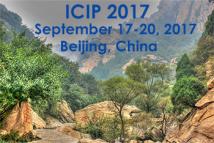
The International Conference on Image Processing (ICIP), sponsored by the IEEE Signal Processing Society, is the premier forum for the presentation of technological advances and research results in the fields of theoretical, experimental, and applied image and video processing. ICIP has been held annually since 1994, brings together leading engineers and scientists in image and video processing from around the world. Visit website.
- Read more about A Novel Variational Model for Retinex in Presence of Severe Noises
- Log in to post comments
Retinex theory deals with compensation for illumination effects in images, which is usually an ill-posed problem. The existence of noises may severely challenge the performance of Retinex algorithms. Therefore, the main aim of this paper is to present a general variational Retinex model to effectively and robustly restore images corrupted by both noises and intensity inhomogeneities. Our strategy is to simultaneously recover the noise-free image and decompose it into reflectance and illumination component.
- Categories:
 14 Views
14 Views- Read more about CONTRASTIVE-CENTER LOSS FOR DEEP NEURAL NETWORKS
- Log in to post comments
The deep convolutional neural network(CNN) has significantly raised the performance of image classification and face
- Categories:
 10 Views
10 Views- Read more about viewpoint calibration method based on point features for point cloud fusion
- Log in to post comments
In this study, we propose a 3D viewpoint calibration method. The method relies on the novel combination of 3D-SIFT (scale-invariant feature transform) keypoints and FPFH (fast point feature histogram) features, which are used for feature matching. Based on the feature correspondences, we compute the transformation to resolve the difference of the viewpoints.
- Categories:
 35 Views
35 Views- Read more about LOW-LIGHT IMAGE ENHANCEMENT USING CNN AND BRIGHT CHANNEL PRIOR
- Log in to post comments
Poster.pdf
- Categories:
 106 Views
106 Views- Read more about 360-degree Video Stitching for Dual-fisheye Lens Cameras Based On Rigid Moving Least Squares
- Log in to post comments
Dual-fisheye lens cameras are becoming popular for 360-degree video capture, especially for User-generated content (UGC), since they are affordable and portable. Images generated by the dual-fisheye cameras have limited overlap and hence require non-conventional stitching techniques to produce high-quality 360x180-degree panoramas. This paper introduces a novel method to align these images using interpolation grids based on rigid moving least squares. Furthermore, jitter is the critical issue arising when one applies the image-based stitching algorithms to video.
- Categories:
 285 Views
285 Views- Read more about 3-D Mean-Separation-Type Short-Time DFT with Its Application to Moving-Image Denoising
- Log in to post comments
Although for a still image the 2-D DFT and the 2-D DCT have similar properties to each other, for a moving-image sequence the 3-D DFT gets an advantage of representing the sequence more compactly over the 3-D DCT. Through the mathematical analysis of the 3-D DFT and the 3-D DCT based on a simple signal model of a moving-image sequence, this paper shows that the even symmetrization employed implicitly by the 3-D DCT may cause deterioration of representation efficiency and hence the 3-D DFT can achieve better representation efficiency than the 3-D DCT.
- Categories:
 8 Views
8 Views- Read more about Copy move forgery detection with similar but genuine objects
- Log in to post comments
Copy-Move Forgery Detection (CMFD) is a well-studied
image forensics problem. However, CMFD with Similar but
Genuine Objects (SGO) has received relatively less attention.
Recently, it has been found that current state-of-the-art
CFMD techniques are mostly inadequate in satisfactorily
solving this important problem variant. In this paper, we have
addressed this issue by using Rotated Local Binary Pattern
(RLBP) based rotation-invariant texture features, followed
by Generalized Two Nearest Neighbourhood (g2NN) based
ICIP_Poster.pdf
- Categories:
 16 Views
16 Views- Read more about A Directed Graph Approach to Active Contours
- Log in to post comments
Active contours based on level sets are popular segmentation algorithms but their local optimization approach makes their results to depend on initialization, especially for edge-based formulations. In this paper we present a novel energy minimization method based on directed graph optimization that minimizes the same type of active contour energy function without the need of an initialization.
- Categories:
 9 Views
9 ViewsWe look at the problem of developing a compact and accurate model for gesture recognition from videos in a deep-learning framework. Towards this we propose a joint 3DCNN-LSTM model that is end-to-end trainable and is shown to be better suited to capture the dynamic information in actions. The solution achieves close to state-of-the-art accuracy on the ChaLearn dataset, with only half the model size. We also explore ways to derive a much more compact representation in a knowledge distillation framework followed by model compression.
- Categories:
 8 Views
8 Views